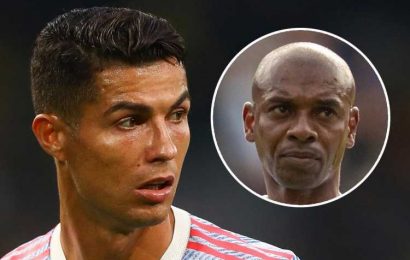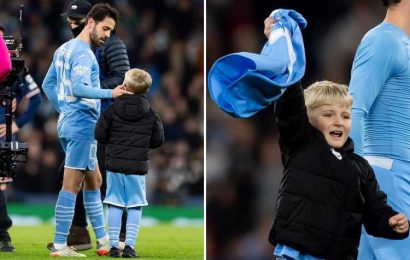Quarterback Caleb Williams’ decision last week to transfer to USC wasn’t the least bit surprising given his ties to new coach Lincoln Riley.
But the reaction to Williams’ decision at Pac-12 headquarters, which acknowledged the news on multiple media platforms, was completely unprecedented and entirely appropriate.
It left us flabbergasted, frankly, but in a good way for the future of Pac-12 football messaging. The conference office should take a more active role in spreading the word when teams score major victories in the talent acquisition game.
Welcome to a discussion about a commissioner with a knack for social media, an evolving strategy in San Francisco and the fair but unequal treatment of the 12 football programs.
Let’s start with the timeline of events:
— On Feb. 1, Williams announced his decision to join the Trojans via his Twitter account at 9:03 a.m.
— Approximately two hours later, Pac-12 commissioner George Kliavkoff retweeted a video clip from ESPN’s SportsCenter and quoted a line from the show about the Williams news: “Axis shift in college football.”
— By mid-afternoon, the Pac-12’s main Twitter account had blasted out a link to an article published on the conference website: “Check out what people are saying about @USC_FB adding transfer QB @CALEBcsw”
— The article itself featured a dash of background information on Williams and displayed a series of glowing tweets from former Trojans and reactions to the news by media outlets.
Granted, it was huge news. National news. Here was the No. 1 quarterback in the transfer portal, a potential Heisman Trophy candidate, joining forces with his high-profile former coach in the nation’s largest media market at one of the sport’s blue-blood programs.
It immediately dominated the news cycle, as we’d expect.
But the reaction on official Pac-12 platforms was wholly unexpected.
To the best of our knowledge, the conference’s social media accounts had never trumpeted news about the arrival of a specific recruit or transfer. They are all about the teams, the current athletes and (occasionally) the alumni.
In the past, HQ might have worried about accusations of preferential treatment or been leery of setting a precedent. But this is a new era.
That became clear last summer, when Kliavkoff spoke publicly about the difference between fair and equal treatment when it comes to strategic issues like football scheduling.
Kliavkoff’s presence on social media isn’t new. He’s active and engaged but careful not to get sucked into the weeds. He generally tweets about conference initiatives and collective successes — a stark contrast to his predecessor, Larry Scott, who didn’t have a Twitter account (at least an official one).
When Kliavkoff retweeted the SportsCenter clip about Williams, we noticed. And when the conference’s social media team followed up a few hours later, we definitely noticed.
An entire article on Williams seven months before he’ll set foot on the Coliseum field?
We don’t recall a similar reaction from San Francisco three years ago when mega-recruit Kayvon Thibodeaux signed with Oregon.
Or when USC’s basketball team signed Evan Mobley, the No. 1 big man in the country, two years ago.
Or even last winter, when five-star quarterback Sam Huard signed with Washington.
But Williams was national news, because of his success last season at Oklahoma, in a way those players weren’t.
And Kliavkoff understands the value of social media messaging. (His tweet about Williams gave the social media team the cover it needed to publish the article.)
And, crucially, the schools recognize that times have changed, that fair doesn’t mean equal. (We aren’t aware of any grumbling about the publication of content on Williams from any of the other 11 campuses.)
So what’s next? How will Kliavkoff and the conference office determine when a transfer or recruit is worthy of a tweet or an entire article or — dare we say it — a TikTok video?
Clearly, HQ cannot promote intra-conference transfers; it must focus on players entering the league. And it can’t become entangled in bar-setting or line-drawing. The messaging has to be organic … what feels right under the circumstances.
But make no mistake: It should use the Williams situation as propellant.
Why not create a social media team in San Francisco that’s entirely devoted to football recruiting, a team that’s in daily contact with the player personnel staffs at each program, a team that’s designed to complement and augment what the schools are doing.
The content could be directed at specific recruits, either subtly or overtly, depending on the situation and the limits of NCAA rules.
Related Articles
-
Though schedule crunch looms, stretch run features favorable matchups for CU Buffs -
Pac-12 football 2022 outlook: Winners and losers from the transfer portal -
Kiszla vs. Chambers: Could high-scoring Avalanche and Pioneers both bring championships home to Denver? -
Nebraska fans checking out as Fred Hoiberg’s Huskers continue to flounder -
CU Buffs men’s basketball gets back on track with rout of Oregon State
It could be designed to promote specific campuses, academic disciplines or the conference writ large — all of it geared toward brand enhancement.
And it could include members of the recently-created Football Alumni Council, which includes former players or coaches from every school and is designed “to leverage the knowledge and promotional power of prominent Pac-12 football alumni in support of the Pac-12’s football goals, which include elevating the football brands of all schools and the Pac-12, supporting recruiting efforts.”
The conference had the good sense to create the Council. Why not provide the social media support to make the most of it?
College football is undergoing immense change with the transfer portal, the era of name, image and likeness and the NCAA’s refusal to provide oversight on either.
Meanwhile, the Pac-12 has reached a tipping point as the sagging on-field performance collides with a likely delay in playoff expansion and the upcoming, momentous media rights negotiations.
Kliavkoff and his executives are willing to consider everything.
The athletic directors and head coaches are open to anything.
There’s no better time than now to reinvent the approach to football messaging at HQ.
Support the Hotline: Receive three months of unlimited access for just 99 cents. Yep, that’s 99 cents for 90 days, with the option to cancel anytime. Details are here, and thanks for your support.
*** Send suggestions, comments and tips (confidentiality guaranteed) to [email protected] or call 408-920-5716
*** Follow me on Twitter: @WilnerHotline
*** Pac-12 Hotline is not endorsed or sponsored by the Pac-12 Conference, and the views expressed herein do not necessarily reflect the views of the Conference.
Source: Read Full Article







